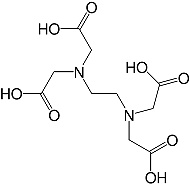Ethylenediamine tetraacetic acidanalytical grade
(EDTA, Ethylenedinitrilo-tetraacetic acid)
C10H16N2O8 • Mr 292.3 • CAS [60-00-4]
Ethylenediaminetetraacetic acid (EDTA) chelates metal divalent cations like
calcium, magnesium by forming metal-EDTA complexes.
EDTA is used in a wide
range of applications: as a buffer component in nucleic acid purification and
electrophoresis, an inhibtor of enzymes like metalloproteases and nucleases,
an anti-bacterial agent and in cleaning products and detergent formulations.
Assay (titr.)
|
min. 99.0 %
|
EG-Index: 607-429-00-8 •
EINECS: 200-449-4 •
WGK: 2L •
HS: 29212900
Storage Temperature: +15 °C to +30 °C
*Please use the inquiry form in the right column.
Certificates of Analysis
(Lot.-no. - release date)
Material Safety Datasheets
You may find this also interesting:
SERVA InfoMail - Get the latest information
Close window
When subscribing to »SERVA InfoMail« you will receive information about the latest product release, special promotions, new jobs at SERVA and more. This service is, of course, free of charge.
You may remove your name any time from the list of recipients.
Quick Order
Close window
Using the Quick Order field, you can add a product to your shopping cart with just one click. All you have to do: enter the Cat.No. as shown in our catalog in the format xxxxx.yy and click the Go!-Button.
Close window
H319
Deutsch:
Verursacht schwere Augenreizung.
English:
Causes serious eye irritation.
Français:
Provoque une sévère irritation des yeux.
Italiano:
Provoca grave irritazione oculare.
Español:
Provoca irritación ocular grave.
Close window
H332
Deutsch:
Gesundheitsschädlich bei Einatmen.
English:
Harmful if inhaled.
Français:
Nocif par inhalation.
Italiano:
Nocivo se inalato.
Español:
Nocivo en caso de inhalación.
Close window
H373
Deutsch:
Kann die Organe schädigen <alle betroffenen Organe nennen, sofern bekannt> bei längerer oder wiederholter Exposition <Expositionsweg angeben, wenn schlüssig belegt ist, dass diese Gefahr bei keinem anderen Expositionsweg besteht>.
English:
May cause damage to organs <or state all organs affected, if known> through prolonged or repeated exposure <state route of exposure if it is conclusively proven that no other routes of exposure cause the hazard>.
Français:
Risque présumé d'effets graves pour les organes <ou indiquer tous les organes affectés, s'ils sont connus> à la suite d'expositions répétées ou d'une exposition prolongée <indiquer la voie d'exposition s'il est formellement prouvé qu'aucune autre voie d'exposition ne conduit au même danger>.
Italiano:
Può provocare danni agli organi <o indicare tutti gli organi interessati, se noti> in caso di esposizione prolungata o ripetuta <indicare la via di esposizione se è accertato che nessun'altra via di esposizione comporta il medesimo pericolo>.
Español:
Puede provocar daños en los órganos <indíquense todos los órganos afectados, si se conocen> tras exposiciones prolongadas o repetidas <indíquese la vía de exposición si se ha demostrado concluyentemente que el peligro no se produce por ninguna otra vía>.
Close window
P260
Deutsch:
Staub/Rauch/Gas/Nebel/Dampf/Aerosol nicht einatmen.
English:
Do not breathe dust/fume/gas/mist/vapours/spray.
Français:
Ne pas respirer les poussières/fumées/gaz/brouillards/vapeurs/aérosols.
Italiano:
Non respirare la polvere/i fumi/i gas/la nebbia/i vapori/gli aerosol.
Español:
No respirar el polvo/el humo/el gas/la niebla/los vapores/el aerosol.
Close window
P264
Deutsch:
Nach Gebrauch … gründlich waschen.
English:
Wash … thoroughly after handling.
Français:
Se laver … soigneusement après manipulation.
Italiano:
Lavare accuratamente … dopo l’uso.
Español:
Lavarse … concienzudamente tras la manipulación.
Close window
P280
Deutsch:
Schutzhandschuhe/Schutzkleidung/Augenschutz/Gesichtsschutz tragen.
English:
Wear protective gloves/protective clothing/eye protection/face protection.
Français:
Porter des gants de protection/des vêtements de protection/un équipement de protection des yeux/du visage.
Italiano:
Indossare guanti/indumenti protettivi/Proteggere gli occhi/il viso.
Español:
Llevar guantes/prendas/gafas/máscara de protección.
Close window
P304 +P340
Deutsch:
BEI EINATMEN: An die frische Luft bringen und in einer Position ruhigstellen, die das
Atmen erleichtert.
English:
IF INHALED: Remove victim to fresh air and keep at rest in a position comfortable for breathing.
Français:
EN CAS D’INHALATION: transporter la victime à l’extérieur et la maintenir au repos dans une position où elle peut confortablement respirer.
Italiano:
IN CASO DI INALAZIONE: trasportare l'infortunato all’aria aperta e mantenerlo a riposo in posizione che favorisca la respirazione.
Español:
EN CASO DE INHALACIÓN: Transportar a la víctima al exterior y mantenerla en reposo en una posición confortable para respirar.
Close window
P305 +P351 +P338
Deutsch:
BEI KONTAKT MIT DEN AUGEN: Einige Minuten lang behutsam mit Wasser spülen.
Vorhandene Kontaktlinsen nach Möglichkeit entfernen. Weiter spülen.
English:
IF IN EYES: Rinse cautiously with water for several minutes. Remove contact lenses, if present and easy to do. Continue rinsing.
Français:
EN CAS DE CONTACT AVEC LES YEUX: rincer avec précaution à l’eau pendant plusieurs minutes. Enlever les lentilles de contact si la victime en porte et si elles peuvent être facilement enlevées. Continuer à rincer
Italiano:
IN CASO DI CONTATTO CON GLI OCCHI: sciacquare accuratamente per parecchi minuti. Togliere le eventuali lenti a contatto se è agevole farlo. Continuare a sciacquare.
Español:
EN CASO DE CONTACTO CON LOS OJOS: Aclarar cuidadosamente con agua durante varios minutos. Quitar las lentes de contacto, si lleva y resulta fácil. Seguir aclarando.
Close window
P337 +P313
Deutsch:
Bei anhaltender Augenreizung: Ärztlichen Rat einholen/ärztliche Hilfe hinzuziehen.
English:
If eye irritation persists: Get medical advice/attention.
Français:
Si l’irritation oculaire persiste: consulter un médecin.
Italiano:
Se l’irritazione degli occhi persiste, consultare un medico.
Español:
Si persiste la irritación ocular: Consultar a un médico.











